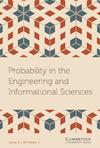逐渐消失事件的Cox模型
IF 1
3区 工程技术
Q4 ENGINEERING, INDUSTRIAL
Probability in the Engineering and Informational Sciences
Pub Date : 2022-01-13
DOI:10.1017/S0269964821000553
引用次数: 0
摘要
医学创新使我们的寿命更长、更健康,从而降低了死亡率。由于人工智能在医疗保健领域的进步,更长的寿命迟早会成为可能。同样,高度自动化车辆中的高级驾驶辅助系统(ADAS)可以通过感知危险情况来减少甚至最终消除事故,这将最大限度地减少事故数量,并减少保险公司的损失索赔。为了建立更长的寿命和反映更少事故的索赔数量的幸存者函数模型,本文研究了一个强度过程是分段常数和递减的Cox过程。我们得到了它的最终分布性质,如强度积分过程的拉普拉斯变换,点过程的概率生成函数,它们的相关矩和累积量,以及给定时间点不再要求的概率。一般来说,这个简单的模型可能适用于许多其他领域,用于模拟逐渐消失的事件的演变,例如公司违约,股息支付,贸易到达,劳动力市场中某种工作类型(例如打字员)的就业以及颗粒的释放。特别地,我们讨论了一些潜在的保险应用。本文章由计算机程序翻译,如有差异,请以英文原文为准。
A Cox model for gradually disappearing events
Abstract Innovations in medicine provide us longer and healthier life, leading lower mortality. Sooner rather than later, much greater longevity would be possible for us due to artificial intelligence advances in health care. Similarly, Advanced Driver Assistance Systems (ADAS) in highly automated vehicles may reduce or even eventually eliminate accidents by perceiving dangerous situations, which would minimize the number of accidents and lead to fewer loss claims for insurance companies. To model the survivor function capturing greater longevity as well as the number of claims reflecting less accidents in the long run, in this paper, we study a Cox process whose intensity process is piecewise-constant and decreasing. We derive its ultimate distributional properties, such as the Laplace transform of intensity integral process, the probability generating function of point process, their associated moments and cumulants, and the probability of no more claims for a given time point. In general, this simple model may be applicable in many other areas for modeling the evolution of gradually disappearing events, such as corporate defaults, dividend payments, trade arrivals, employment of a certain job type (e.g., typists) in the labor market, and release of particles. In particular, we discuss some potential applications to insurance.
求助全文
通过发布文献求助,成功后即可免费获取论文全文。
去求助
来源期刊
CiteScore
2.20
自引率
18.20%
发文量
45
审稿时长
>12 weeks
期刊介绍:
The primary focus of the journal is on stochastic modelling in the physical and engineering sciences, with particular emphasis on queueing theory, reliability theory, inventory theory, simulation, mathematical finance and probabilistic networks and graphs. Papers on analytic properties and related disciplines are also considered, as well as more general papers on applied and computational probability, if appropriate. Readers include academics working in statistics, operations research, computer science, engineering, management science and physical sciences as well as industrial practitioners engaged in telecommunications, computer science, financial engineering, operations research and management science.

 求助内容:
求助内容: 应助结果提醒方式:
应助结果提醒方式:


